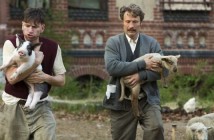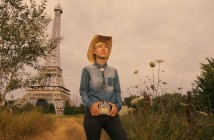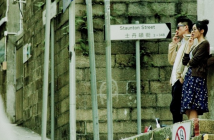
Editor’s Notes: The Jungle Book opens in wide theatrical release today, April 15th.
Disney would prefer you forget – assuming you remembered in the first place, that is – that they re-adapted Rudyard Kipling’s The Jungle Book two decades ago. That adaptation was more reimagining than remake, departed heavily from both the source material and the 1967 animated musical, aging the central character, Mowgli, into a young adult and turning his adventures into an ersatz Tarzan story. Of course, an even earlier, non-Disney adaptation made in the 1940s not only went the live-action route, but also jettisoned the fantastical elements found in Kipling’s book. The newest take, The Jungle Book, takes a hybrid approach, mixing live-action with photo-realistic or near photo-realistic CGI. In fact, given that director Jon Favreau (Chef, Iron Man, Zathura, Elf, Swingers) shot The Jungle Book primarily in front of green screens on a soundstage, it’s more the latter (CGI) than the former (live-action). It’s everything moviegoers have come to expect from a combination of Disney’s seemingly endless resources and cutting-edge technology, breathtaking and awe-inspiring in equal measures, but it’s also tonally inconsistent story and character wise.
The newest take, The Jungle Book, takes a hybrid approach, mixing live-action with photo-realistic or near photo-realistic CGI.
Favreau surrounds the young, preteen Mowgli (Neel Sethi) with an anthropomorphic cast of dozens, if not hundreds, beginning with Bagheera (voiced by Sir Ben Kingsley), the black panther who found an abandoned Mowgli as an infant and left him with a wolf pack headed by Akela (Giancarlo Esposito) and Raksha (Lupita Nyong’o) to raise him into a young “man-cub.” Mowgli may be different, but he’s also accepted, treated with kindness, compassion, and respect by Bagheera and his wolf pack. With a drought in play, jungle rules dictate that predators and prey set aside biological imperatives and share the local watering hole. The truce, however, doesn’t hold up for long. Shere Khan (Idris Elba), a man-hating Bengal tiger, spots Mowgli at the watering hole and demands the wolf pack turn Mowgli over to him where he’ll meet a certain death.

Despite the carefully calibrated, digitally created sun beams illuminating fauna and foliage alike, The Jungle Book takes a dark, even grim turn, probably too grim and too dark for smaller children: To avoid Khan’s death sentence, Bagheera convinces Akela and Raksha to set aside their paternal and maternal instincts respectively and allow him to escort Mowgli back to his own kind in a not-too-distant man village. Thematically, Mowgli’s forced expulsion and journey back to “civilization” turns on notions of family (biological and otherwise), social norms (empathy vs. self-preservation), and community (inclusive vs. exclusive). Favreau integrates these themes into narrative and character with a light touch, generally avoiding the tendency toward preaching or sermonizing typical of Hollywood-made, family-oriented films. He has far more difficulty, however, in finding and managing a consistent tone throughout The Jungle Book, sometimes veering wildly between humor-filled, comedic interludes and ultra-intense, life-threatening scenes of Mowgli attempting to escape or Shere Khan’s claws and teeth.
The more comedic interludes arrive courtesy of Baloo (Bill Murray), an idle, indolent, honey-obsessed brown bear that saves Mowgli from certain death . . .
The more comedic interludes arrive courtesy of Baloo (Bill Murray), an idle, indolent, honey-obsessed brown bear that saves Mowgli from certain death at the bone- and organ-crushing clutches of Kaa (Scarlett Johansson), a seductively sibilant snake. Baloo, however, doesn’t save Mowgli out of a self-sacrificing, heroic impulse (that comes later, at the end of his character arc), but for Mowgli’s climbing abilities. Claiming a life debt as motivation, Baloo convinces Mowgli to help him acquire honey from cliff side-dwelling bees. Mowgli ignores Bagheera’s longstanding advice and begins to utilize “tricks” (i.e., technology) to help him extract the honey from the bee colony. Mowgli’s ingenuity, initially seen as an obstacle to his integration into the jungle community (theme alert), proves more than helpful when the obligatory confrontation with Shere Khan arrives in a third act crammed with one breathless, hair-raising escape after another for Mowgli and a community (the wolf pack, Bagheera, and Baloo, among others) who unite to defeat a common, otherwise unbeatable enemy (“strength in numbers” theme alert).
The Jungle Book also deserves some, albeit minor, credit for downplaying, if not outright eliminating Kipling’s pro-colonialist, pro-imperialist leanings, instead adopting a pro-inclusion, pro-altruism take on the material. It’s telling that Favreau’s adaptation ends differently than Kipling’s book or even the animated musical, but to say more would be to spoil a sequel-ready ending that celebrates differences as much as it embraces the spirit of community. Thematic consistency aside, however, The Jungle Book fails on occasion to seamlessly integrate the live action and the CGI, resulting in several artifice- and illusion-breaking moments. Still, those moments are few and far between in a film that succeeds in providing moviegoers with a memorably tactile, texture-rich experience.
It’s everything moviegoers have come to expect from a combination of Disney’s seemingly endless resources and cutting-edge technology, breathtaking and awe-inspiring in equal measures, but it’s also tonally inconsistent story and character wise.



